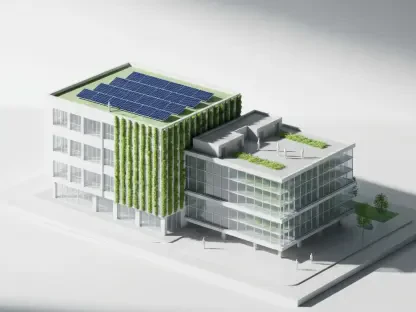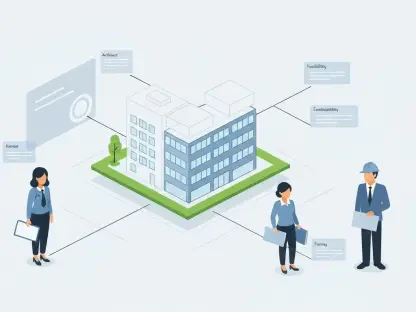In recent years, China has embarked on an expansive journey to transform its urban development strategies, with a keen focus on sustainable growth and green infrastructure. The nation is not just responding to environmental pressures but is actively crafting policies that align with its dual carbon goals of reaching peak emissions by 2030 and achieving carbon neutrality by 2060. Under Xi Jinping’s leadership, these initiatives have become crucial to the country’s future economic landscape, offering a comprehensive framework for sustainable urbanization. This pivot is not merely ecological but also economic, with significant implications for global investors. Opportunities abound in areas like smart cities, green buildings, and regional revitalization. The transformative shift involves integrating cutting-edge technology and targeted funding, effectively changing the landscape of urban planning and investment.
The Green Building Revolution
China’s green building revolution marks a significant stride toward achieving its environmental objectives. Central to this revolution is the adoption and implementation of low-carbon technologies and energy-efficient building materials. Transition finance mechanisms, particularly preferential loans, have become essential instruments in facilitating this shift. By offering reduced interest rates for industries traditionally burdened by high emissions, the government is successfully encouraging a transition to more sustainable practices. Meanwhile, international collaborations highlight the global dimension of this initiative. Partnerships like the Sino-Swiss Zero Emission Building Project exemplify how cross-border cooperation can accelerate these efforts. This project is just one instance of how international cooperation can bring about meaningful progress in reducing carbon footprints, bringing like-minded nations together in a shared mission to tackle climate change.
In the realm of green building, China is not only pioneering new methods but also setting benchmarks that could influence global standards. Policies supporting low-carbon development have gained traction, with real estate developers increasingly collaborating with technology firms to create integrated solutions. The incorporation of cutting-edge technologies such as artificial intelligence (AI) and the Internet of Things (IoT) is becoming more prevalent in the construction industry, further optimizing energy use and reducing waste. As these resources become more accessible, investment opportunities in green building projects continue to expand, attracting global attention. With such structural reforms in place, the momentum is undeniable, and the potential for significant financial returns is alluring to investors worldwide.
Smart Cities: Integrating Technology with Urban Life
The concept of smart cities is at the forefront of China’s urban transformation, with technology playing a pivotal role in redefining urban living. The New Quality Productive Forces strategy underlines the importance of digitization and automation, seamlessly integrating them into urban planning. Cities like Shanghai’s Lingang New Area are leading this endeavor, offering substantial subsidies to foster intelligent projects. These initiatives are emblematic of China’s broader ambition to weave AI, IoT, and renewable energy into the urban fabric. The implications are profound, as these cities not only enhance the quality of life but also create avenues for new business models and economic growth. The streamlined integration of technology into everyday life presents both challenges and immense opportunities, paving the way for a future where urban areas are not only sustainable but also self-sufficient.
Investors are increasingly attracted to sectors that support this digital revolution, including firms focused on 5G infrastructure, data analytics, and smart grid development. Public-private partnerships are gaining ground, providing a collaborative platform for technological advancement in urban environments. Hangzhou and Shenzhen have become hubs for AI-driven initiatives, showcasing how technology can enhance transportation, energy management, and communication networks. The potential for growth in these areas is vast, making smart cities a focal point for strategic investment. As the digital landscape continues to evolve, China’s push toward smart urban environments represents an essential shift in addressing modern-day challenges while simultaneously opening up new economic avenues.
Regional Development: Bridging Urban-Rural Gaps
Addressing the urban-rural divide is another critical aspect of China’s comprehensive urban strategy, with regional development forming a cornerstone of this effort. The Rural Comprehensive Revitalization Plan, spanning from 2025 to 2027, focuses on upgrading essential infrastructure, including water, energy, and waste management systems. Enhanced agricultural digitization also features prominently, offering pathways to improve efficiency and productivity in rural areas. By investing in modern techniques and technologies, China seeks to create a symbiotic relationship between urban and rural regions, stimulating economic activity across the board. Programs such as the Rural E-commerce Development Program are instrumental in this transformation, linking farmers to urban markets and fostering economic growth.
China’s regional development efforts are bearing fruit, notably in the western areas, which present untapped potential for investors. With tax breaks and land cost advantages, these regions offer lucrative opportunities for growth and development. By incentivizing investment, China is creating a conducive environment for sustainable infrastructure projects, ultimately fostering balanced regional development. The strategic diversification of investments across geographies further mitigates risks and assures sustained economic growth. As these initiatives progress, the bridge between urban and rural dynamics will continue to solidify, promoting an inclusive and sustainable economic landscape that supports long-term prosperity for all regions involved.
A Future of Balanced Growth and Opportunities
China is making great strides in its green building revolution, aligning with its environmental goals by embracing low-carbon technologies and energy-efficient materials. Transition finance, especially through preferential loans, plays a crucial role in this transformation, offering reduced interest rates to industries with historically high emissions to foster a shift toward sustainable practices. International collaborations add a global dimension, exemplified by initiatives like the Sino-Swiss Zero Emission Building Project, illustrating the power of cross-border alliances in mitigating climate change.
China not only innovates with new methods in green building but also sets standards potentially impacting worldwide practices. Policies boosting low-carbon development are gaining momentum, with real estate developers working closely with tech firms to devise integrated solutions. Advanced technologies such as AI and IoT are increasingly employed in construction, optimizing energy use and minimizing waste. With these strides, investment in green building is not only expanding but is also drawing international interest. Structural reforms fuel a drive that promises significant financial returns for global investors.









